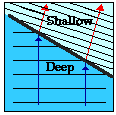Question #a6528
1 Answer
Refraction is an abrupt change in the direction a wave travels that occurs when the wave passes from one medium to another.
Explanation:
Refraction occurs as waves cross a boundary at an angle to the boundary because one portion of the wave will enter the new medium ahead of others portions, as in the picture below:

In this diagram, the part of the wave on the right has encountered the boundary earlier than the part on the left. The wave slows down in the shallower water, and so the longer it has been travelling in the shallow part, the further it lags behind the part of the wave still in the deeper water.
The effect is to cause a sudden change in the direction the wave is travelling (as shown by the two rays).
In the case of light, the speed of the wave depends on the nature of the medium in a similar way. If the light slows, its path is bent in a way that causes it to travel closer to a line drawn normal to the boundary between the media.
Refraction is governed by Snell's Law:
where

